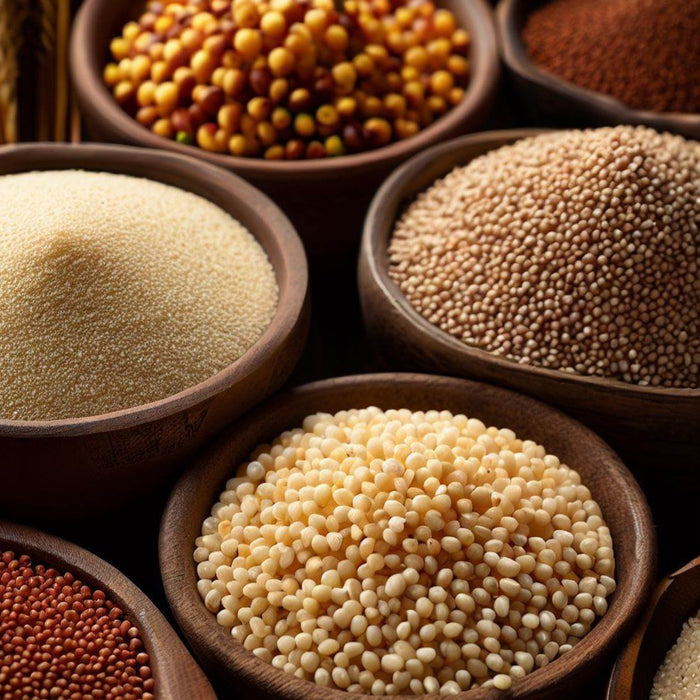

Uncover the Difference Between Millet, Wheat, and Rice
As staple foods in India, millet, wheat, and rice are commonly used in various cuisines. Each grain is unique in terms of appearance, taste, nutritional content, and culinary uses. Understanding the differences between them can help you make informed dietary choices and explore new recipes.
Millet is a small, nutrient-dense, gluten-free grain that has been cultivated for thousands of years. With a slightly nutty flavor and a fluffy texture, millet is versatile and can be used in many dishes, from porridges to bread. Wheat, on the other hand, is a major cereal crop that is rich in gluten, a protein that gives elasticity to dough and is commonly used in baking. Rice, the most widely consumed grain in the world, is a cereal crop that comes in many varieties, each with its own unique flavor and texture.
Key Takeaways:
- Millet, wheat, and rice are staple foods in India.
- Millet is a small, nutrient-dense, gluten-free grain with a slightly nutty flavor.
- Wheat is a major cereal crop rich in gluten, commonly used in baking.
- Rice is a widely consumed grain with many varieties, each with its own unique flavor and texture.
Nutritional Comparison of Millet, Wheat, and Rice
When it comes to nutritional content, millet, wheat, and rice all have unique profiles. Let's take a closer look at their macronutrients and micronutrients to better understand their health benefits.
| Millet (1 cup cooked) | Wheat (1 cup cooked) | White Rice (1 cup cooked) | |
|---|---|---|---|
| Calories | 207 | 151 | 205 |
| Protein (g) | 6 | 6.5 | 4.3 |
| Fat (g) | 1.7 | 1.2 | 0.4 |
| Carbohydrates (g) | 41 | 31.4 | 44.5 |
| Fiber (g) | 2.3 | 4.6 | 0.6 |
| Vitamin B1 (mg) | 0.3 | 0.2 | 0.1 |
| Vitamin B3 (mg) | 1.7 | 3.2 | 2.2 |
| Vitamin B6 (mg) | 0.1 | 0.3 | 0.2 |
| Vitamin E (mg) | 0.1 | 0.2 | 0 |
| Iron (mg) | 1.6 | 1.5 | 0.4 |
| Magnesium (mg) | 51 | 56 | 19 |
| Phosphorus (mg) | 165 | 127 | 115 |
| Potassium (mg) | 195 | 170 | 55 |
| Zinc (mg) | 1.2 | 1.1 | 0.9 |
As we can see, millet is the most calorie-dense of the three grains, while wheat has the highest protein content and is the richest in fiber. White rice, on the other hand, is lowest in both protein and fiber. Millet and wheat both contain significant amounts of B vitamins, while rice is only a good source of vitamin B3. All three grains contain iron and zinc, but millet is the highest in both minerals. Magnesium and potassium are abundant in millet and wheat, while rice is relatively low in both.
Overall, all three grains have their own unique health benefits and nutritional advantages. Incorporating a variety of grains into your diet is the best way to ensure you are getting a balanced mix of essential nutrients.
Culinary Uses of Millet, Wheat, and Rice in Indian Cuisine
Millet, wheat, and rice are staples in Indian cuisine and are used in a variety of traditional dishes. They can be cooked in numerous ways and accompany a wide range of flavors. In this section, we will explore the different cooking methods that are used to prepare these grains and the dishes in which they are commonly featured.
Cooking Methods for Millet, Wheat, and Rice
Millet is generally cooked using the absorption method, where it is boiled in water or broth until all the liquid is absorbed. It can also be roasted or fried and used in salads, soups, and stews. Wheat, on the other hand, is often ground into flour and used to make bread, noodles, and pastries. Rice is boiled with an excess of water, which is then drained after cooking. It is also used to make desserts, such as rice pudding.
Popular Dishes Using Millet, Wheat, and Rice
One popular Indian dish made using millet is multigrain roti that can be made using Naario's 9 in 1 flour mixed with regular wheat flour. You can also make chillas, dosa, cakes, or other daily food items by mixing Naario's 9 in1 flour mix. Millet is also used to make kheer, a sweet dessert. Wheat is used in the preparation of numerous dishes, such as chapati, naan, puri, and paratha. It is also used to make noodles, which are known as seviyan. Rice is used in biryani, a one-pot rice dish made with vegetables or meat. It is also used to prepare idli, dosa, and appam – all of which are traditional South Indian breakfast foods.
Cultural Significance of Millet, Wheat, and Rice
In Indian culture, grains have deep cultural and religious significance. Rice, for instance, is considered a symbol of prosperity and is often offered to deities during religious ceremonies. Wheat is an important crop in North India and is associated with the harvest season. Millet, which was widely consumed across India until the Green Revolution, is now often considered a "poor man's food," but it is still an important crop for farmers in drought-prone areas.
Millet as a Gluten-Free Option and Alternative Grain
Millet is a highly versatile and nutritious grain that is naturally gluten-free, making it an excellent choice for individuals with gluten sensitivities or celiac disease. It has a mild taste and can be used in a variety of dishes, including porridges, pilafs, and salads.
One advantage of millet as a gluten-free alternative to wheat is its high fiber content. Millet is a good source of both soluble and insoluble fiber, which can help to regulate digestion, improve heart health, and lower cholesterol levels.
When using millet as a substitute for wheat flour, it is important to note that millet flour has a different texture and behaves differently in baking. For best results, it is recommended to use a blend of gluten-free flours, such as millet flour, rice flour, and tapioca flour.
Other alternative grains that can be substituted for wheat include quinoa, amaranth, and teff. These grains offer a range of unique health benefits and can be used in a variety of dishes.
Exploring Other Millets and Their Benefits
While we've already taken a deep dive into millet, there are actually several types of millet worth exploring. Here are some of the other millets and the benefits they offer:
| Type of Millet | Nutritional Content | Unique Characteristics and Benefits |
|---|---|---|
| Pearl Millet | Rich in protein, fiber, and minerals like iron and magnesium | Ideal for making flatbread and porridge; helps control blood sugar levels and aids in digestion |
| Finger Millet | Packed with calcium, fiber, and antioxidants | Often used to make dosa, idli, and porridge; helps strengthen bones, decrease blood cholesterol levels, and support immune function |
| Foxtail Millet | Low in calories and fat, high in fiber and iron | Can be used in a variety of dishes, from upma to kheer; supports digestion, aids in weight loss, and helps regulate blood sugar levels |
As you can see, each type of millet offers its own unique advantages. Whether you're looking to increase your protein intake, control your blood sugar levels, or support your immune system, there's a millet out there for you.
Conclusion
In conclusion, millet, wheat, and rice are three of the most commonly consumed grains in India. While they share similarities in texture and taste, they differ greatly in their nutritional profiles and culinary uses.
Nutritional Benefits
In terms of nutrition, millet is a great source of fiber, protein, and essential minerals like magnesium and phosphorus. It's also gluten-free, making it a great alternative for those with gluten sensitivities. Wheat, on the other hand, is rich in carbohydrates and protein, and is a good source of B vitamins. Rice is a staple in Indian cuisine and provides carbohydrates, some protein, and a small amount of dietary fiber.
Culinary Uses
Each grain has its own specific culinary uses and cooking methods in Indian cuisine, from millet-based breakfast dishes like idlis and dosas, to wheat-based flatbreads like roti and paratha. Rice is a staple in many dishes such as biryani and pulao.
Millet as an Alternative Grain
Millet's advantage as a gluten-free alternative to wheat makes it a great option for those with gluten sensitivities or celiac disease. It can be substituted for wheat flour in baking and cooking, and is commonly used to make gluten-free rotis and breads. Other alternative grains that can be substituted for wheat include quinoa, amaranth, and buckwheat.
Other Millets and Their Benefits
There are various types of millets, each with their own unique characteristics and benefits. Pearl millet is a rich source of protein and fiber, while finger millet is packed with calcium and iron. Foxtail millet is gluten-free, low in glycemic index, and high in antioxidants. These millets can be used in a variety of dishes, from porridges and salads to desserts and even beer.
In summary, incorporating a variety of grains like millet, wheat, and rice into our diets can provide a plethora of health benefits and culinary delights. With their versatility and nutritional advantages, it's no wonder that these grains hold such a significant place in Indian food culture.
FAQ
Q: What is the difference between millet, wheat, and rice?
A: Millet, wheat, and rice are three different types of grains. They differ in terms of appearance, taste, nutritional content, and culinary uses. Millet is a small, round grain with a mild, nutty flavor. Wheat is a larger grain with a slightly sweet taste. Rice is a staple food with a neutral flavor.
Q: Are millet, wheat, and rice equally nutritious?
A: While all three grains provide essential nutrients, their nutritional profiles vary. Millet is rich in fiber, protein, and minerals like magnesium and phosphorus. Wheat is a good source of fiber, protein, and B vitamins. Rice is high in carbohydrates and provides some minerals and vitamins.
Q: How are millet, wheat, and rice used in Indian cuisine?
A: Millet is commonly used to make flatbreads, porridges, and side dishes. Wheat is used to make various breads, chapatis, and pastries. Rice is a staple in many Indian dishes, such as biryani and pulao.
Q: Can millet be used as a gluten-free alternative to wheat?
A: Yes, millet is a gluten-free grain, making it a suitable option for individuals with gluten sensitivities or celiac disease. It can be used in place of wheat flour in baking and cooking.
Q: Are there other types of millet besides the common variety?
A: Yes, besides the common millet variety, there are other types such as pearl millet, finger millet, and foxtail millet. These millets have their own unique characteristics, nutritional benefits, and culinary uses.
1 comment
-
Good informative article. This encapsulates that all grains have unique benefits and wheat and rice are also equally good for health.
Anil Kumar Joshi on
